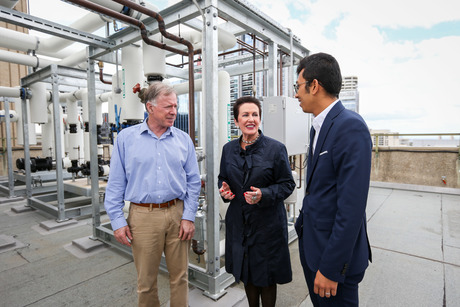City of Sydney says it is time to modernise ageing electricity network

In July 2015, the City of Sydney, the Property Council of Australia and the Total Environment Centre made a joint proposal to the Australian Energy Market Commission to modernise Australian energy regulations to keep up with changing technologies and customer preferences.
The proposal calls for local electricity generators such as trigeneration plants and renewables to receive credits and pay lower network charges because they put less strain on ageing electricity networks, particularly during peak demand times and significant events. These credits would cost significantly less than building new power lines, improving efficiency while bringing down network costs overall.
Lord Mayor Clover Moore said in NSW, coal-fired electricity was transported from the Hunter Valley, Snowy Mountains, Gunnedah and Broken Hill, all the way to Sydney.
“Yet a customer who buys energy from a local generator, such as a building across the street, pays the same network charges even though they don’t even use the transmission network,” the Lord Mayor said.
The City’s proposed rule would be more equitable as it would create an incentive for generation to be located in the parts of the network with the highest value.
In September, the Commission released a draft determination rejecting the proposal, arguing it could lead to increased electricity prices. The City made a submission to the draft determination last week.
“It’s time Australia’s energy regulators caught up with changing technologies and customer preferences,” the Lord Mayor said. “Our population is growing, especially in the capital cities and urban centres. As demand for electricity grows and our infrastructure continues to age, we should be doing all we can to ensure catastrophes such as we recently saw in South Australia don’t happen again.
“I was dumbfounded by the Australian Energy Market Commission’s dismissal of our proposal on cost grounds, particularly when modelling from the Institute of Sustainable Futures showed a proposal similar to this could save more than $1 billion by 2050.
“We’re doing what we can. We’ve put more than half a megawatt of solar panels on our building roofs — equivalent to more than 200 household solar PV systems — switched on a trigeneration plant at Town Hall House and we’re also installing a low-carbon cogeneration plant at the Ian Thorpe Aquatic Centre in Ultimo,” she explained.
“Apart from the fact these energy generators have helped us reduce emissions in our own buildings and operations by 27% on 2006 levels, they also offer the state’s electricity grid more reliability by reducing pressure on the grid. As we recently saw in South Australia, cities like Sydney cannot be too reliant on centralised energy networks. We need decentralised, alternative options.
“Our current regulatory regime was designed for the 20th century, where one-way centralised energy supply was the only way to go. Currently, decentralised energy projects are not able to access funding for the value they provide to the network. This makes them more costly to get off the ground.
“If networks don’t develop fair, efficient pricing for local generation, consumers will increasingly avoid the network by locating generation off the grid — increasing prices for the customers who remain — and have to pay for the poles and wires already installed.”
“It’s just not credible to argue, as the Commission has, that existing mechanisms, specifically network support payments by the energy utilities, are working to support local energy generation — these payments amount to less than 0.03% of total network expenditure.
“Unfortunately, the Commission has decided it cannot consider climate change because it is not part of the National Electricity Objective — which means they are not planning for the electricity grid of the future as we move to zero emissions by 2050. We need to include climate change in the National Electricity Objective so climate policy and energy markets start working together.
“In rejecting the proposal, the Commission does not appear to have even considered the potential viability of alternatives to improve efficiency and bring down costs the Commission itself had proposed to stakeholders earlier this year,” said Moore.
The City of Sydney’s submission called on the Commission to delay its final determination and proposed alternative rule changes to address the concerns of the Commission.
“The Commission needs to properly address the inadequacies of its draft determination, better consider alternative proposals and wait for the outcomes of the independent review into the National Electricity Market which is underway,” the Lord Mayor said.
“Our growing population and ageing electricity network need more reliability and the answer lies in alternative, decentralised energy sources such as trigeneration and solar power. This is a great opportunity to modernise Australia’s energy regulations, encourage alternative cleaner sources of energy and offer our ageing electricity networks more reliability.”
Mars Wrigley to boost Asquith factory with new production line
Mars Wrigley Australia is installing a new production line at its Asquith factory to boost...
Welding body calls for a nation-building approach to combat Trump's tariffs
Weld Australia believes that US tariffs offer Australia a unique opportunity to carve out a new...
New free TAFE courses aim to develop manufacturing skills
The NSW Government has announced four new free TAFE courses designed to upskill Australians and...








